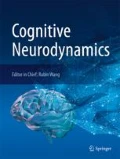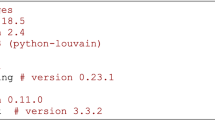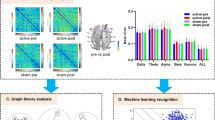Abstract
In recent years, the number of patients with neurodegenerative diseases (i.e., Alzheimer’s disease, Parkinson’s disease, mild cognitive impairment) and mental disorders (i.e., depression, anxiety and schizophrenia) have increased dramatically. Researchers have found that complex network analysis can reveal the topology of brain functional networks, such as small-world, scale-free, etc. In the study of brain diseases, it has been found that these topologies have undergoed abnormal changes in different degrees. Therefore, the research of brain functional networks can not only provide a new perspective for understanding the pathological mechanism of neurological and psychiatric diseases, but also provide assistance for the early diagnosis. Focusing on the study of human brain functional networks, this paper reviews the research results in recent years. First, this paper introduces the background of the study of brain functional networks under complex network theory and the important role of topological properties in the study of brain diseases. Second, the paper describes how to construct a brain functional network using neural image data. Third, the common methods of functional network analysis, including network structure analysis and disease classification, are introduced. Fourth, the role of brain functional networks in pathological study, analysis and diagnosis of brain functional diseases is studied. Finally, the paper summarizes the existing studies of brain functional networks and points out the problems and future research directions.



Similar content being viewed by others
Data availability statement
Not applicable.
Abbreviations
- AAL:
-
Anatomical automatic labeling
- BOLD:
-
Blood oxygenation level dependent
- CAD:
-
Computer aided diagnosis
- EEG:
-
Electroencephalogram
- fMRI:
-
Functional magnetic resonance imaging
- ICA:
-
Independent component analysis
- MEG:
-
Magnetoencephalography
- PCA:
-
Principal component analysis
- ROI:
-
Region of interest
- SVD:
-
Singular value decomposition
- SVM:
-
Support vector machine
- SPM:
-
statistical parametric mapping toolkit
- TSCI:
-
Traumatic complete spinal cord injury.
- WHO:
-
World Health Organization
References
Adkinson JA, Karumuri B, Hutson TN, Liu R, Alamoudi O, Vlachos I, Iasemidis L (2019) Connectivity and centrality characteristics of the epileptogenic focus using directed network analysis. IEEE Trans Neural Syst Rehabil Eng 27(1):22–30
Allen EA, Damaraju E, Plis SM, Erhardt EB, Eichele T, Calhoun VD (2014) Tracking whole-brain connectivity dynamics in the resting state. Cereb Cortex 24(3):663–676
Atluri G, Iii M, Lim KO, Kumar V (2016) The brain-network paradigm: using functional imaging data to study how the brain works. Computer 49(10):65–71
Bansal K, Nakuci J, Muldoon SF (2018) Personalized brain network models for assessing structure function relationships. Curr Opin Neurobiol 52:42–47
Bassett DS, Sporns O (2017) Network neuroscience. Nat Neurosci 20(3):353–364
Beckmann CF (2010) Toward discovery science of human brain function. Proc Natl Acad Sci U S A 71(10):4734–4739
Bressler SL, Menon V (2010) Large-scale brain networks in cognition: emerging methods and principles. Trends Cogn Sci 14(6):277–290
Buckner RL, Andrewshanna JR, Schacter DL (2008) The brain’s default network: anatomy, function, and relevance to disease. Ann NY Acad Sci 1124(1):1–38
Bullmore E, Sporns O (2009) Complex brain networks: graph theoretical analysis of structural and functional systems. Nat Rev Neurosci 10(3):186–198
Bullmore E, Sporns O (2012) The economy of brain network organization. Nat Rev Neurosci 13(13):336–349
Cao B, Kong X, Yu PS (2015a) A review of heterogeneous data mining for brain disorder identification. Brain Inf 2(4):253–264
Cao B, Kong X, Zhang J, Yu PS, Ragin AB (2015b) Identifying hiv-induced subgraph patterns in brain networks with side information. Brain Inf 2(4):211–223
Cecchi GA, Rao AR, Centeno MV, Baliki M, Apkarian AV, Chialvo DR (2007) Identifying directed links in large scale functional networks: application to brain fMRI. Bmc Cell Biol 8(Suppl(1)13):S5
Ciric R, Nomi JS, Uddin LQ, Satpute AB (2017) Contextual connectivity: a framework for understanding the intrinsic dynamic architecture of large-scale functional brain networks. Sci Rep7(6537)
Craddock RC, Jbabdi S, Yan CG, Vogelstein J, Castellanos FX, Martino AD, Kelly C, Heberlein K, Colcombe S, Milham MP (2013) Imaging human connectomes at the macroscale. Nat Methods 10(6):524–539
Dickten H, Porz S, Elger CE, Lehnertz K (2016) Weighted and directed interactions in evolving large-scale epileptic brain networks. Sci Rep 6:34824
Drysdale AT, Grosenick L, Downar J, Dunlop K, Mansouri F, Meng Y, Fetcho RN, Zebley B, Oathes DJ, Etkin A (2017) Erratum: Resting-state connectivity biomarkers define neurophysiological subtypes of depression. Nat Med 23(1):28–38
Du Y, Lin D, Yu Q, Sui J, Chen J, Rachakonda S, Adali T, Calhoun VD (2017) Comparison of iva and gig-ica in brain functional network estimation using fMRI data. Front Neurosci 267(11):1–18
Eickhoff SB, EStephan K, Mohlberg H, Grefkes C, Finkade GR, Amunts K, Zilles K, (2005) A new spm toolbox for combining probabilistic cytoarchitectonic maps and functional imaging data. Neuroimage 25(4):1325–1335
Eickhoff SB, Nichols TE, Horn JDV, Turner JA (2016) Sharing the wealth: neuroimaging data repositories. Neuroimage 124(Pt B):1065–1068
Enzhong LI, Gao JH, Guangming LU, Peng YH, Dong ED (2015) Functional neuroimaging and its applications to critical brain diseases. Sci China Earth Sci 45(3):237–246
Fei F, Jie B, Zhang D (2014) Frequent and discriminative subnetwork mining for mild cognitive impairment classification. Brain Connect 4(5):347–360
Figueroa CA, Cabral J, Mocking RJT, Rapuano KM, van Hartevelt TJ, Deco G, Expert P, Schene AH, Kringelbach ML, Ruh HG (2019) Altered ability to access a clinically relevant control network in patients remitted from major depressive disorder. Hum Brain Mapp 40(9):2771–2786
Griffa A, Ricaud B, Benzi K, Bresson X, Daducci A, Vandergheynst P, Thiran JP, Hagmann P (2017) Transient networks of spatio-temporal connectivity map communication pathways in brain functional systems. Neuroimage 155:490–502
Guo H, Cao X, Liu Z, Li H, Chen J, Zhang K (2013) Machine learning classifier using abnormal brain network topological metrics in major depressive disorder. NeuroReport 23(17):1006–1011
Hipp JF, Engel AK, Siegel M (2011) Oscillatory synchronization in large-scale cortical networks predicts perception. Neuron 69(2):387–396
Hojjati SH, Ebrahimzadeh A, Khazaee A, Babajaniferemi A (2017) Predicting conversion from mci to ad using resting-state fMRI, graph theoretical approach and SVM. J Neurosci Methods 282:69–80
Huang S, Li J, Ye J, Fleisher A, Chen K, Wu T, Reiman E (2011) Brain effective connectivity modeling for Alzheimer’s disease by sparse gaussian bayesian network. In: International conference on knowledge discovery & data mining (KDD), pp 931–939
Ide JS, CsR Li (2018) Time scale properties of task and resting-state functional connectivity: detrended partial cross correlation analysis. Neuroimage 173:240–248
Ide JS, Zhang S, CsR Li (2014) Bayesian network models in brain functional connectivity analysis. Int J Approx Reason 55(1):23–35
Jiang T, Yong H, Zang Y, Weng X (2010) Modulation of functional connectivity during the resting state and the motor task. Hum Brain Mapp 22(1):63–71
Jie B, Zhang DQ (2016) The novel graph kernel for brain networks with application to mci classification. Chin J Comput 39(8):1667–1680
John M, Ikuta T, Ferbinteanu J (2017) Graph analysis of structural brain networks in Alzheimer’s disease: beyond small world properties. Brain Struct Func 222(2):1–20
Katwal SB, Gore JC, Marois R, Rogers BP (2013) Unsupervised spatiotemporal analysis of fMRI data using graph-based visualizations of self-organizing maps. IEEE Trans Biomed Eng 60(9):2472–2483
Kaushal M, Oni-Orisan A, Chen G, Li W, Leschke J, Ward BD, Kalinosky BT, Budde MD, Schmit BD, Li SJ (2016) Evaluation of whole-brain resting-state functional connectivity in spinal cord injury—a large-scale network analysis using network based statistic. J Neurotrauma 34(6):1278–1282
Khajehpour H, Mohagheghian F, Ekhtiari H, Makkiabadi B, Harirchian MH (2019) Computer-aided classifying and characterizing of methamphetamine use disorder using resting-state eeg. Cogn Neurodyn 13(6):519–530
Khalili NM, Rombouts SA, van Osch MJ, Duff EP, Carbonell F, Nickerson LD, Becerra L, Dahan A, Evans AC, Soucy JP (2017) Biomarkers, designs, and interpretations of resting-state fMRI in translational pharmacological research: a review of state-of-the-art, challenges, and opportunities for studying brain chemistry. Hum Brain Mapp 38(4):2276–2325
Khazaee A, Ebrahimzadeh A, Babajani-Feremi A (2017) Classification of patients with mci and ad from healthy controls using directed graph measures of resting-state fMRI. Behav Brain Res 322(Pt B):339–350
Kong X, Yu PS (2010) Semi-supervised feature selection for graph classification. In: 16th ACM sigkdd international conference on knowledge discovery and data mining, pp 793–802
Kong X, Yu PS (2014) Brain network analysis: a data mining perspective. ACM SIGKDD Explor Newsl 15(2):30–38
Kourosh JK, Kamran P, Fatemeh H, Bruce R (2018) The effect of region of interest size on the repeatability of quantitative brain imaging biomarkers. IEEE Trans Biomed Eng 66(3):864–872
Kucyi A, Hove MJ, Esterman M, Hutchison RM, Valera EM (2016) Dynamic brain network correlates of spontaneous fluctuations in attention. Cereb Cortex 27(3):1831–1840
Lefort-Besnard J, Bassett DS, Smallwood J, Margulies DS, Bzdok D (2018) Different shades of default mode disturbance in schizophrenia: subnodal covariance estimation in structure and function. Hum Brain Mapp 39(2):644–661
Li K, Guo L, Nie J, Li G, Liu T (2009) Review of methods for functional brain connectivity detection using fMRI. Comput Med Imaging Graph Off J Comput Medi Imaging Soc 33(2):131–139
Li W, Yang C, Shi F, Wang Q, Wu S, Lu W, Li S, Nie Y, Zhang X (2018) Alterations in normal aging revealed by cortical brain network constructed using ibaspm. Brain Topogr 31(9):1–14
Li Y, Hou C, Yao L, Zhang C, Zheng H, Zhang J, Long Z (2019) Disparity level identification using the voxel-wise gabor model of fMRI data. Hum Brain Mapp 40(5):2596–2610
Liang X, Wang JH, He Y (2010) Human connectome: structural and functional brain networks. Chin Sci Bull 55(16):1565–1583
Liang X, Hsu LM, Lu H, Sumiyoshi A, He Y, Yang Y (2018) The rich-club organization in rat functional brain network to balance between communication cost and efficiency. Cereb Cortex 28(3):924–935
Liao W, Ding J, Marinazzo D, Xu Q, Wang Z, Yuan C, Zhang Z, Lu G, Chen H (2011) Small-world directed networks in the human brain: multivariate granger causality analysis of resting-state fMRI. Neuroimage 54(4):2683–2694
Liao W, Qiu C, Gentili C, Walter M, Pan Z, Ding J, Zhang W, Gong Q, Chen H (2012) Altered effective connectivity network of the amygdala in social anxiety disorder: a resting-state fMRI study. PLoS ONE 5(12):e15238
Lopes R, Delmaire C, Defebvre L, Moonen AJ, Duits AA, Hofman P, Leentjens AFG, Dujardin K (2017) Cognitive phenotypes in Parkinson’s disease differ in terms of brain-network organization and connectivity. Hum Brain Mapp 38(3):1604–1621
Lord LD, Expert P, Huckins JF, Turkheimer FE (2013) Cerebral energy metabolism and the brain’s functional network architecture: an integrative review. J Cereb Blood Flow Metab Off J Int Soc Cereb Blood Flow Metab 33(9):1347–1354
Lukic AS, Wernick MN, Strother SC (1999) An evaluation of methods for detecting brain activations from pet or fMRI images. Nucl Sci Symp 2:1119–1123
Ma G, He L, Lu CT, Yu PS, Shen L, Ragin AB (2016) Spatio-temporal tensor analysis for whole-brain fMRI classification. In: Proceedings of the 2016 SIAM international conference on data mining (SDM), pp 819–827
Margulies DS, Böttger J, Long X, Lv Y, Kelly C, Schäfer A, Goldhahn D, Abbushi A, Milham MP, Lohmann G (2010) Resting developments: a review of fMRI post-processing methodologies for spontaneous brain activity. Magn Reson Mater Phys Biol Med 23(5–6):289–307
Martijn H, Sporns O (2013) Network hubs in the human brain. Trends Cognit Sci 17(12):683–696
Mp VDH, Hulshoff Pol HE (2010) Exploring the brain network: a review on resting-state fMRI functional connectivity. Eur Neuropsychopharmacol 20(8):519–534
Mwansisya TE, Hu A, Li Y, Chen X, Wu G, Huang X, Lv D, Li Z, Liu C, Xue Z (2017) Task and resting-state fMRI studies in first-episode schizophrenia: a systematic review. Schizophr Res 189:9–18
Patterson C (2018) World Alzheimer report 2018: the state of the art of dementia research: new frontiers. Alzheimer’s Disease International, London
Pereira F, Mitchell T, Botvinick M (2009) Machine learning classifiers and fMRI: a tutorial overview. Neuroimage 45(1):S199–S209
Pfurtscheller G, da Silva Lopes FH (1999) Event-related EEG/MEG synchronization and desynchronization: basic principles. Clin Neurophysiol 110(11):1842–1857
Pillai AS, Jirsa VK (2017) Symmetry breaking in space-time hierarchies shapes brain dynamics and behavior. Neuron 94(5):1010–1026
Power JD, Fair DA, Schlaggar BL, Petersen SE (2010) The development of human functional brain networks. Neuron 67(5):735–748
Power JD, Cohen AL, Nelson SM, Wig GS, Barnes KA, Church JA, Vogel AC, Laumann TO, Miezin FM, Schlaggar BL (2011) Functional network organization of the human brain. Neuron 72(4):665–678
Prince M, Comas-Herrera A, Knapp M, Guerchet M, Karagiannidou M (2016) World Alzheimer report 2016: improving healthcare for people living with dementia: coverage, quality and costs now and in the future. Alzheimer’s Disease International (ADI), London
Pruttiakaravanich A, Songsiri J (2016) A review on dependence measures in exploring brain networks from fMRI data. Eng J 20:208–233
Pu J, Wang J, Yu W, Shen Z, Lv Q, Zeljic K, Zhang C, Sun B, Liu G, Wang Z (2015) Discriminative structured feature engineering for macroscale brain connectomes. IEEE Trans Med Imaging 34(11):2333
Salvador R, Suckling J, Coleman MR, Pickard JD, Menon D, Bullmore E (2005) Neurophysiological architecture of functional magnetic resonance images of human brain. Cereb Cortex 15(9):1332–1342
Sheline YI, Raichle ME, Snyder AZ, Morris JC, Head D, Wang S, Mintun MA (2010) Amyloid plaques disrupt resting state default mode network connectivity in cognitively normal elderly. Biol Psychiatry 67(6):584–587
Shi L, Sun J, Ren Z, Chen Q, Wei D, Yang W, Qiu J (2018) Large-scale brain network connectivity underlying creativity in resting-state and task fMRI: Cooperation between default network and frontal-parietal network. Biol Psychol 135:102–111
Thompson WH, Fransson P (2018) A common framework for the problem of deriving estimates of dynamic functional brain connectivity. Neuroimage 172:896–902
Tian L (2010) Analysis of complex brain networks based on graph theory. Beijing Biomed Eng 29:96–100
Tomše P, Jensterle L, Grmek M, Zaletel K, Pirtošek Z, Dhawan V, Peng S, Eidelberg D, Ma Y, Trošt M, (2017) Abnormal metabolic brain network associated with Parkinson’s disease: replication on a new european sample. Neuroradiology 59(5):1–9
Vergara VM, Mayer A, Damaraju E, Kiehl K, Calhoun VD (2017) Detection of mild traumatic brain injury by machine learning classification using resting state functional network connectivity and fractional anisotropy. J Neurotrauma 34(5):45–53
Wang C, Sun C, Xi Z, Wang Y, Qi H, Feng H, Xin Z, Ying Z, Wan B, Du J (2015) The brain network research of poststroke depression based on partial directed coherence(pdc). Chin J Biomed Eng 34(1):385–391
Wang J, Zuo X, He Y (2010) Graph-based network analysis of resting-state functional MRI. Front Syst Neurosci 4(16):1–14
Wang X, Lin Q, Xia M, He Y (2018a) Differentially categorized structural brain hubs are involved in different microstructural, functional, and cognitive characteristics and contribute to individual identification. Hum Brain Mapp 39(4):1647–1663
Wang Y, Wang R, Zhu Y (2017) Optimal path-finding through mental exploration based on neural energy field gradients. Cogn Neurodyn 11(1):99–111
Wang Z, Wang R (2014) Energy distribution property and energy coding of a structural neural network. Front Comput Neurosci. https://doi.org/10.3389/fncom.2014.00014
Wang Z, Xin J, Wang X, Wang Z, Zhao Y, Qian W (2018b) Voxelwise-based brain function network using multi-graph model. Sci Rep 8(1):17754
Wei DT, Meng J, Ya Dan LI, Zhang QL, Qiu J (2015) Application of big neuroimaging data from individual difafferences in psychological research. Chin Sci Bull 60(11):976–985
Xu H, Su J, Qin J (2018) Impact of global signal regression on characterizing dynamic functional connectivity and brain states. Neuroimage 173:127–145
Yao D, Zhang Y, Liu T, Xu P, Gong D, Lu J, Xia Y, Luo C, Guo D, Dong L, Lai Y, Chen K, Li J (2020) Bacomics: a comprehensive cross area originating in the studies of various brain-apparatus conversations. Cogn Neurodyn. https://doi.org/10.1007/s11571-020-09577-7
Yao Z, Hu B, Xie Y, Philip M, Zheng J (2015) A review of structural and functional brain networks: small world and atlas. Brain Inf 2(1):45–52
Yoldemir B, Ng B, Abugharbieh R (2016) Stable overlapping replicator dynamics for brain community detection. IEEE Trans Med Imaging 35(2):529–538
Zhao S, Han J, Lv J, Jiang X, Hu X, Zhao Y, Ge B, Guo L, Liu T (2015) Supervised dictionary learning for inferring concurrent brain networks. IEEE Trans Med Imaging 34(10):2036–2045
Zhou Z, Chen Y, Ding M, Wright P, Lu Z, Liu Y (2010) Analyzing brain networks with pca and conditional granger causality. Hum Brain Mapp 30(7):2197–2206
Zhu Z, Wang R, Zhu F (2018) The energy coding of a structural neural network based on the Hodgkin–Huxley model. Front Neurosc. https://doi.org/10.3389/fnins.2018.00122
Acknowledgements
Not applicable.
Funding
This work was supported by the National Natural Science Foundation of China (61472069, 61402089, U1401256, 61672146), and the Fundamental Research Funds for the Central Universities (N2019007, N180101028, N180408019), and the China Postdoctoral Science Foundation (2019T120216 and 2018M641705), and the CETC Joint Fund, and the Recruitment Program of Global Experts under Grant (01270021814101/022).
Author information
Authors and Affiliations
Contributions
ZYW and JCX collected the background information. ZYW, JCX and ZQW analyzed and compared the current research situation. ZW, JX had the major responsibility for preparing the paper, ZYW, ZQW and YDY wrote part of the paper. JCX, YZ and WQ. supervised the project. All authors read and approved the final manuscript.
Corresponding author
Ethics declarations
Ethics approval and consent to participate
Not applicable.
Consent for publication
Not applicable.
Competing interests
The authors declare that they have no competing interests.
Additional information
Publisher's Note
Springer Nature remains neutral with regard to jurisdictional claims in published maps and institutional affiliations.
Rights and permissions
About this article
Cite this article
Wang, Z., Xin, J., Wang, Z. et al. Brain functional network modeling and analysis based on fMRI: a systematic review. Cogn Neurodyn 15, 389–403 (2021). https://doi.org/10.1007/s11571-020-09630-5
Received:
Revised:
Accepted:
Published:
Issue Date:
DOI: https://doi.org/10.1007/s11571-020-09630-5




